#sourdoughbread
Explore tagged Tumblr posts
Text
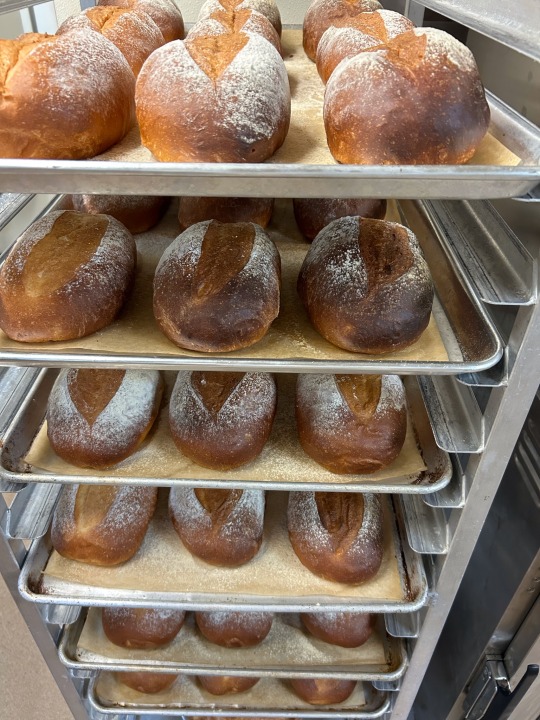
Bread time.
35 notes
·
View notes
Text




Savory Sourdough Happiness 🍞🧀
Baked a homemade sourdough bread – with salami and cheese right inside the dough.
Crispy crust, soft center, and packed with flavor.
Baking just hits different, especially when it smells this good! 😋��
Real. Imperfect. With heart.💙
#sourdough#sourdoughbread#homemade bread#bread baking#savorybread#bakingfromscratch#salamiandcheese#bakinglove#breadlover#realbread#sourdoughlove#breadlovers#homebaking#home baking#comfortfood#fresh bread#artisanbread#bakeandshare#bread art#crustyoutside#softinside#homemadegoodness#food photography#cozybaking#cheese bread#bakingjoy#breadbaker#simplepleasures
5 notes
·
View notes
Text


Big sourdough- well 1kg, is traditionally standard size- made with 7% flaxseed meal and 7% fresh milled chickpeas. Overnight cold proof: healthy and yummy.
Leavened by an Lievito Madre as well as a rye sourdough preferment.
#shatinbread#homebaker#hkigfood#sourdough#shatinfood#germanbread#sauerteig#852food#sourdoughbread#realbread#ryestarter#lievotomadre#bread#hkbread#hksourdoughclub#bread is life
2 notes
·
View notes
Text
Experiment number 550,000 million is completed... 🤣🤣🤣 With most of the rise/proof "wait time" being while I was sleeping... 💤😴 What am I trying to prove? That baking sourdough bread is NOT an EXACT science. It is not that difficult and should not require all these "rules" that people want to make about baking SOURDOUGH... I have pretty much broken every single rule there is... And done exactly what works for me... in the time frame that works for me... I don't use a scale to measure my ingredients for my bread dough... I don't use a scale to weigh the measurements of ingredients that are going to go into my starter... I don't use heating pads or other contraptions or keep my house at a higher temperature so my sourdough starter or dough can stay warm or cold... I do not use filtered water. I use water straight from the tap despite the caution that it might kill the wild yeast. I don't worry about all this exactness with bulk ferment time... cold ferment time yadda yadda yadda...
Newest experiment... Can I make a decent sourdough loaf with minimal Hands-On time... With most of the wait time being while I'm sleeping... And how will it turn out if I use the "cold baked" method... Avoiding the excessive preheat times which to me is an absolute waste of our natural resources....
Came home from work yesterday and at 3:00 p.m. fed my cold straight from the fridge starter. I didn't think I was going to have enough starter for the two loaves I plan on baking today... so I added one full cup of flour and a half a cup of warm water.... (Normally I only do a half a cup of flour and a quarter cup of water but I gave it extra because I need extra starter today...)
By 8:00 p.m. the starter had at least doubled...
To a large Rubbermaid container I added:
1 full cup starter
3.5 cups white flour
1.5 cups wheat flour
1.5 cups water
Mix quickly just to get all the flour mostly incorporated... And Let shaggy dough sit with lid on for 30 minutes. After the 30 minute wait... I added another 1/4 cup water and 2 teaspoons salt... And immediately began stretch and folds every 30 minutes at 8:30 p.m. At 10:30 p.m. I moved the dough to a glass pyrex bowl with a lid. I was going to stop my stretch and folds there but thought better of it and 30 minutes later I did one more stretch and fold.
I left the bowl on the dining room table from 11 P.M. until I woke up at 5:00 a.m.
At 5 A.M. I gently plopped the dough onto the floured counter... And gently floured and formed my dough round to get a little more tension but also trying not to deflate the dough very much...
Placed that onto a piece of parchment paper... Scored the top with one slice down the center and plopped the whole thing into my cold cast iron Dutch oven. I did not have high hopes of this rising as well as it did that's why I only did one score down the center. I wish I had taken a picture but it was definitely much smaller than any of my other ready to bake forms.
As suggested I baked using the "cold bake" method for the first time.
Put oven on 450°. And placed the cold Dutch oven into the cold... But now preheating oven... immediately.
Baked at 450° for 50 minutes.
Removed the lid... And I was surprised to see that it definitely got a good oven spring... Continued baking with lid off for another 10 minutes.
Took temperature of the loaf it was 195°.
Took the loaf out of the Dutch oven and placed directly onto my pizza stone that was already in the oven.
Baked for another 10 minutes until bread reached a temperature of 205 and was more golden brown in color.
I don't know what the inside looks like but I'm not really concerned about that. It looks and smells terrific.
And it was EASY PEASY! Barely any hands on time at all... No fuss... No stress...
Experiment was a success! Total time... From starter initial feed at 3 p.m. to completed bake @ 6:40 a.m. = 16 hours... Hands on time equals approx a measly 20 minutes... 🤣
Note: Image of the starter is actually AFTER a 2nd feeding at 8 P.M. (I forgot to move the time band)... I added another full cup of flour to my remaining starter and another half a cup of water... It more than doubled by the time I got up this morning.
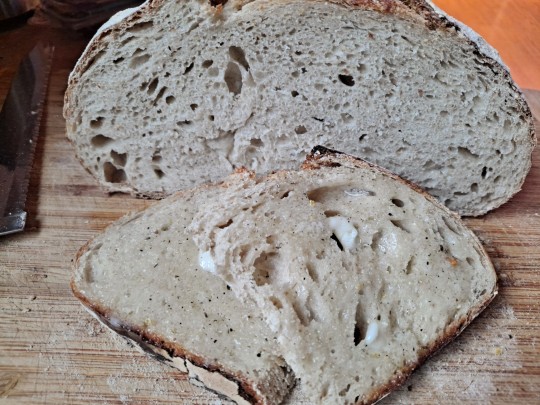

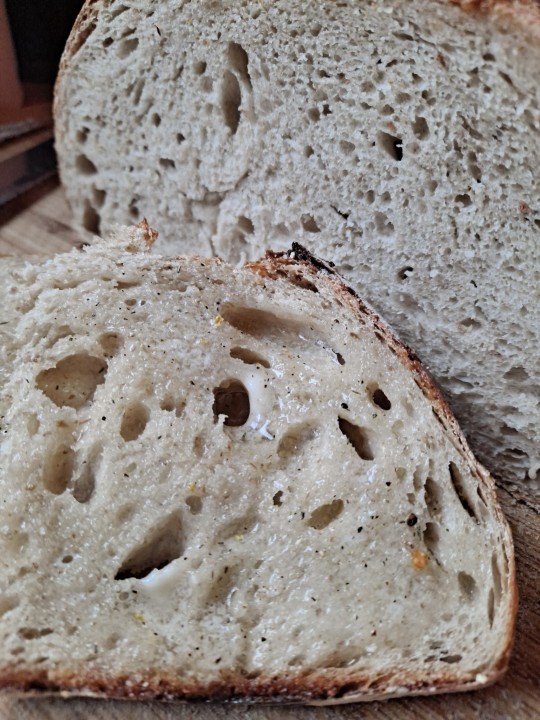




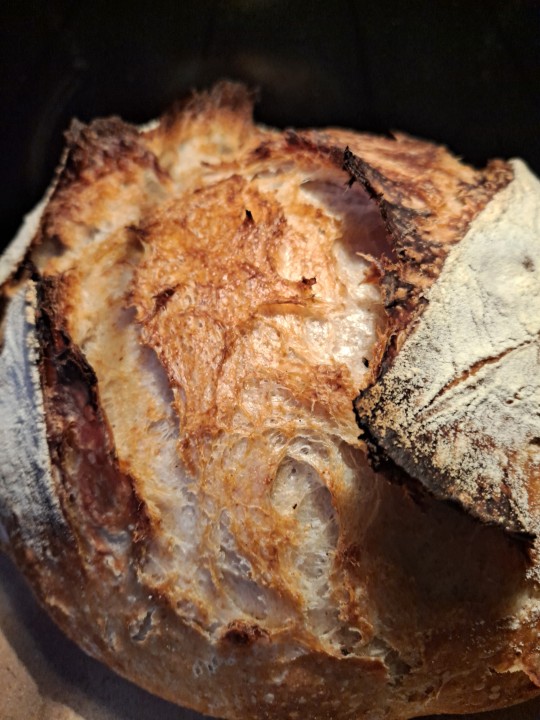
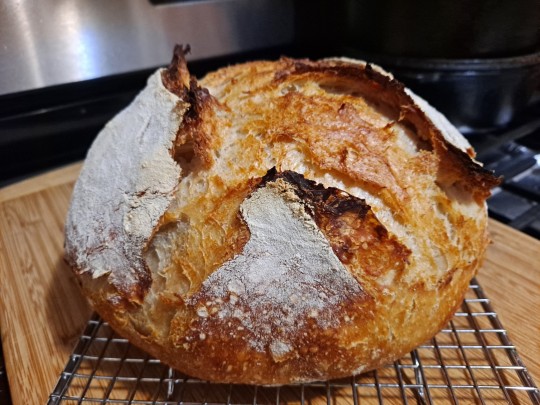

3 notes
·
View notes
Text
Sourdough Bread Market Summary: Trends, Insights, and Key Growth Opportunities
The global sourdough bread market has witnessed a remarkable surge in recent years, driven by changing consumer preferences towards artisanal and healthier bread options. Sourdough bread, known for its distinctive tangy flavor and natural fermentation process, has captured the attention of consumers who are increasingly seeking nutritious and flavorful alternatives to conventional bread.
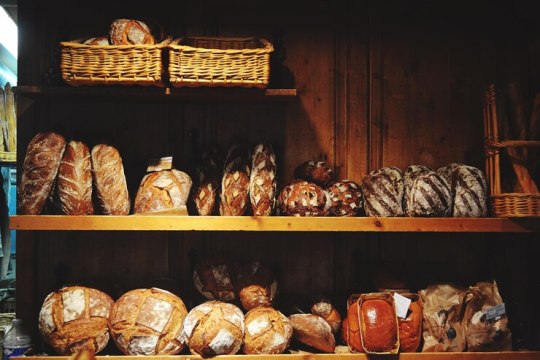
Growing Consumer Demand for Authentic Flavors The market’s growth is largely fueled by a rising demand for authentic flavors and artisanal products. Unlike commercially produced bread, sourdough bread relies on naturally occurring lactobacilli and wild yeasts, resulting in a unique texture and taste that resonates with health-conscious consumers. The traditional fermentation process, which involves long fermentation times, enhances the bread’s digestibility and nutrient profile.
Health and Wellness Drive Market Expansion Sourdough bread aligns well with the health and wellness trends sweeping the food and beverage sector. Its natural fermentation process reduces gluten content, making it easier for some individuals to digest. Furthermore, the slow fermentation increases the availability of certain nutrients and lowers the bread’s glycemic index, making it an appealing choice for those mindful of their blood sugar levels.
Innovative Product Launches and Diverse Flavors Manufacturers are tapping into the growing popularity of sourdough bread by introducing innovative product offerings and a wide variety of flavors. From whole grain and multigrain variants to gluten-free options, the market is expanding rapidly to cater to diverse consumer preferences. Additionally, premium and organic sourdough bread lines are emerging, further boosting the market’s appeal.
Regional Variations and Market Dynamics The sourdough bread market is witnessing regional variations in consumption patterns. In Europe, sourdough bread has a long-standing cultural significance and is a staple in many households. North America has seen a surge in demand driven by the rise of artisan bakeries and consumer awareness of health benefits. Meanwhile, the Asia-Pacific region is gradually embracing sourdough bread as part of a broader shift towards healthier eating habits.
E-Commerce and Direct-to-Consumer Trends The rise of e-commerce platforms and direct-to-consumer channels has significantly expanded the sourdough bread market’s reach. Online sales of sourdough bread and sourdough baking kits have seen a notable uptick, especially during the pandemic-driven baking boom. Artisanal bakeries are leveraging social media and digital platforms to connect with consumers and build brand loyalty.
Sustainability and Local Sourcing Sustainability is another driving force shaping the sourdough bread market. Many artisanal bakeries and commercial producers are focusing on locally sourced ingredients, organic grains, and environmentally friendly packaging. This resonates strongly with eco-conscious consumers and adds to the product’s overall appeal.
Challenges and Market Outlook Despite the positive growth trajectory, the sourdough bread market faces challenges such as the need for skilled bakers to maintain traditional techniques and the relatively higher production costs. However, the market’s future outlook remains bright, with a projected steady increase in demand as more consumers discover the health and taste benefits of sourdough bread.
Conclusion The sourdough bread market summary reveals a dynamic landscape characterized by innovation, health-conscious consumer behavior, and artisanal craftsmanship. As the market continues to evolve, businesses that embrace authenticity, sustainability, and diverse flavor profiles are well-positioned to thrive in this flourishing segment.
0 notes
Text

Yes, but choose wisely! Opt for whole grain, sprouted, or sourdough bread to keep your blood sugar stable. Avoid white or sweetened bread that can cause spikes. Remember, portion control and pairing with protein help manage blood sugar better. Stay healthy and smart with your bread choices! 🍞💪
#DiabetesFriendly#WholeGrainBread#BloodSugarControl#HealthyEating#DiabetesTips#DiabeticDiet#SourdoughBread#SproutedGrain#DiabetesNutrition
0 notes
Text
🍞 sweetsourdoughbreads.com is available!
A flavorful, niche-specific domain perfect for a bakery, food blog, or artisan bread brand. Descriptive, inviting, and ideal for sourdough lovers!
🔗 Grab it now: www.godaddy.com/en-uk/domainsearch/find?domainToCheck=sweetsourdoughbreads.com
0 notes
Text
Bun Recipe
Homemade Buns are soft, fluffy, and perfectly golden—ideal for burgers, sandwiches, or enjoying on their own. With a light, airy texture and a hint of buttery richness, these buns are a versatile addition to any meal. Freshly baked, they offer a warm, comforting aroma and a delicate crust that gives way to a tender interior. Whether you’re making classic burger buns, dinner rolls, or sweet-filled treats, this recipe delivers a homemade touch that elevates any occasion.
#crossbuns#crossbun#bun#buns#bunsrecipe#bunrecipe#bread#BreadLover#breadrecipe#breadpudding#dailybread#bananabread#bananabread🍌#bananabread🍌🍞#bananabreadbeer#sourdoughbread#sourdoughbreads#sourdoughbread🍞#sourdoughbreadrecipe#breadrecipes#breadrolls#breadrolls🍞#BreadRollsRecipe#glutenfreebread#glutenfreebreads#glutenfreebreadrolls#glutenfreebreadrecipe#glutenfreebreadcrumbs
0 notes
Text
0 notes
Text

80% Wholemeal Spelt and Durum Wheat. Leavened by two preferments: Lievito Madre and rye sourdough. Cold proofing 🥶 for 18 hours.
A soaker of psyllium husks is not only healthy but provides moisture for the easy dry baking spelt.
#hkig#shatinbread#homebaker#germanbread#sourdough#sourdoughbread#德國麵包#speltbread#wholemealspelt#dinkelbrot
3 notes
·
View notes
Text
#AirFryerRecipes#VeganMeals#PlantBasedDiet#HealthyComfortFood#OvernightOats#BakedFetaPasta#KetoRecipes#MealPrepIdeas#ComfortFoodWithATwist#FusionCuisine#HealthyDesserts#SourdoughBread#LowCarbMeals
0 notes
Text
Sourdough Bread Market: Exploring the Health Trends Driving Increased Demand for Artisanal Products
The sourdough bread market has witnessed significant growth in recent years, driven by several factors that align with evolving consumer preferences, dietary trends, and an increasing demand for artisanal and healthier food options. These drivers are crucial for understanding why sourdough bread, once a niche product, has become a mainstream staple in many households and restaurants worldwide. This article explores the key drivers of the sourdough bread market, ranging from health-consciousness to innovation in baking processes.

1. Health and Wellness Trends
The growing awareness of the health benefits of sourdough bread has been one of the most significant drivers in the market. Traditional bread, especially those made with commercial yeast, can lead to spikes in blood sugar levels due to its high glycemic index. In contrast, sourdough bread is made through a natural fermentation process using wild yeast and lactic acid bacteria, which not only contribute to its characteristic tangy flavor but also make it easier to digest.
Fermentation breaks down some of the starches in the bread, lowering the glycemic index and making it a healthier choice for individuals with blood sugar concerns or those seeking to manage weight. Additionally, the natural fermentation process enhances the bioavailability of nutrients such as B-vitamins and minerals, making sourdough bread a more nutritious option than conventional bread.
As consumers become more health-conscious, they are increasingly turning to sourdough for its better nutritional profile, including its ability to support gut health through the presence of probiotics produced during fermentation.
2. Rising Demand for Artisan and Craft Foods
In recent years, there has been a marked shift toward the consumption of artisan and craft foods, driven by a desire for authentic, high-quality products. Sourdough bread, traditionally considered a product of artisanal baking, fits perfectly into this trend. The bread’s preparation requires skill, patience, and an understanding of natural fermentation processes, which appeals to consumers looking for authenticity and craftsmanship in their food.
Artisan bakers often prioritize using high-quality, organic ingredients and traditional techniques, which attract consumers seeking a more sustainable and premium product. This trend is especially popular in urban areas where there is a growing demand for local and handcrafted foods. Moreover, the unique flavors, textures, and crusts associated with sourdough appeal to a more discerning palate, further driving its popularity.
3. Increased Awareness of Food Sustainability
Sustainability has become an important factor influencing food choices, and sourdough bread aligns with this trend. The sourdough fermentation process is a natural one that doesn’t require the use of artificial leavening agents or preservatives, which are commonly found in industrially produced breads. Furthermore, many artisanal bakers source their ingredients from local or organic farms, reducing the carbon footprint of their products.
The growing consumer interest in sustainability extends beyond the ingredients to packaging. Many sourdough producers emphasize eco-friendly practices, using recyclable packaging or selling products in reusable containers. This focus on sustainability resonates with eco-conscious consumers who are looking to reduce their environmental impact through their food choices.
4. Popularity of Gluten-Free and Digestive-Friendly Products
While sourdough is not gluten-free, it is often considered easier to digest by people with mild gluten sensitivity, thanks to its unique fermentation process. The presence of wild yeast and lactic acid bacteria helps break down gluten to a certain extent, making sourdough a suitable alternative for individuals who may struggle with traditional bread. This has made sourdough bread more appealing to people who are sensitive to gluten but are not necessarily gluten intolerant.
Moreover, the natural fermentation process also increases the presence of beneficial bacteria, contributing to improved gut health. This aligns with growing consumer interest in digestive health, probiotics, and the gut microbiome, all of which play a role in the increased popularity of sourdough bread as a healthier bread option.
5. Growth in Home Baking and DIY Culture
The COVID-19 pandemic played a significant role in shifting food trends, particularly in the area of home baking. During lockdowns and social distancing measures, many consumers turned to baking as a hobby, with sourdough bread becoming one of the most popular choices. The internet and social media platforms, particularly YouTube and Instagram, saw a surge in sourdough tutorials, sharing tips and recipes for beginners. This has not only made sourdough bread more accessible to a wider audience but has also fueled its popularity among home bakers.
As a result, many consumers are now more familiar with sourdough baking techniques and more willing to try sourdough bread from local bakeries or supermarkets. In turn, the home baking trend has increased demand for raw sourdough starters and related ingredients, contributing to the growth of the market.
6. Innovation in Sourdough Bread Products
Innovation in sourdough bread offerings has played an essential role in expanding the market. While traditional sourdough remains a favorite, there has been an increasing variety of sourdough-based products introduced, including sourdough bagels, crackers, and even sourdough pizza crusts. This product diversification caters to consumers' desire for novel flavors and formats, broadening the appeal of sourdough beyond just bread.
Additionally, modern techniques and improved baking equipment have allowed for faster production of sourdough bread without compromising its traditional qualities. This has enabled sourdough to be produced on a larger scale, making it more accessible and affordable for a wider audience.
Conclusion
The growth of the sourdough bread market is fueled by a combination of health-conscious consumer trends, a shift toward artisanal foods, increasing sustainability concerns, and innovations in product offerings. As consumers continue to prioritize health, authenticity, and sustainability, sourdough bread’s popularity is expected to continue rising. Additionally, the rise of home baking and the availability of new sourdough-based products further solidify its position in the global market. With these factors in play, the future of the sourdough bread market looks promising, with sustained growth driven by evolving consumer preferences.
0 notes
Text
youtube
🥖 Easy Homemade Bread Recipe: Soft & Simple! 🍞✨
Looking for an easy homemade bread recipe that anyone can master? 🍞 In this video, we’ll walk you through how to make homemade bread with minimal effort. Whether you're a beginner or an experienced baker, our recipe ensures you’ll get soft, fluffy bread every time. No fancy equipment required! 🥖
This easy bread recipe is perfect for:
No-knead bread lovers—skip the hard work without sacrificing flavor!
🥪 Sandwich bread recipe to create the ultimate homemade sandwiches.
🥖 Artisan bread recipe that looks and tastes bakery-fresh.
Soft homemade bread that’s great with butter, jam, or your favorite spread.
Learn step-by-step how to make bread with just a few ingredients you probably already have at home. We’ll cover:
How to prepare no-knead bread that’s crispy on the outside and soft inside.
🥚 How to bake bread and store it for long-lasting freshness.
🥖 Making white bread recipe for everyday use.
How to make no-knead bread the easy way, with minimal fuss.
Pro tips for achieving perfect dough without over-kneading.
Why You’ll Love This Recipe
Homemade bread recipes perfect for both beginners and experts.
🕒 Quick and easy methods with no knead bread recipes—ready in no time.
Versatile options: Enjoy as toast, sandwiches, or with soup. 🥪🍲
Fresh, preservative-free bread at home with just a few steps.
Join us and discover the satisfaction of baking homemade bread! Whether you want a basic loaf or are aiming for an artisan bread recipe, this bread homemade recipe will become your new favorite.
#EasyBreadRecipe #HomemadeBread #HowToMakeHomemadeBread #NoKneadBread #BreadRecipe #SoftHomemadeBread #HowToBakeBread
#homemadebread#recipe#bread#homemadefood#homemade#veganrecipe#freshbread#bakingbread#recipes#sourdoughbread#artisanbread#veganrecipes#cake#butter#tasty#pasta#cheese#realbread#Youtube
0 notes
Text

User-Friendly Starter Kit: Designed for both new and expert bakers, our sourdough starter jars wide mouth includes essential tools like a long-handled spatula, thermometer, and feeding indicator band, simplifying the starter process. Efficient Sourdough Jar: With a 24 oz capacity, our wide-mouth glass jar facilitates easy addition of flour and water. Craft three delicious sourdough loaves and effortlessly remove the starter when needed. Real-Time Monitoring Tools: The kit features a spatula for efficient stirring and a thermometer for monitoring the starter's temperature in real-time, ensuring optimal conditions for a thriving sourdough culture.
0 notes
